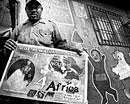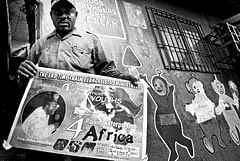

Ace lensman Ryan Lobo’s latest collection of photographs has been shot over the course of several years in war-ravaged Liberia, Afghanistan and Iraq. The horrors and suffering of war, alternating with calmer periods of peace, have been playing themselves in never-ending cycles through the course of human history, Ryan says. Shunning stereotypical “great selling visuals,” he strives through his photographs to go beyond the ordinary and the obvious and draw us out of our complacent cocoons.
“People who have truly suffered do not find it difficult to forgive and this was my experience. Out of suffering and sorrow endured comes a deeper understanding of the world and its humanity, maybe the value of a present moment. There can be no true healing for either side without confessions and then forgiveness.”
Ryan’s images of pain, suffering, loss and contrition may be of far-off places and people, but their experiences reflect the greater human condition that transcends geographical and political boundaries. A picture can capture the deeper truth and be a vital instrument of storytelling. Photography transcends language and culture, tells stories, and presents different ways of looking at people. “I didn’t go with specific questions or seek answers. I tried to let intangibles speak through my photographs,” Ryan adds.
Ryan, the filmmaker
Ryan Lobo co-produced the film, The Redemption of General Butt Naked, with Eric Strauss, Ryan Hill and Daniele Anastasion, which won the award for cinematography at the 2011 Sundance Film Festival. His films have aired on the National Geographic Channel, Animal Planet, The Oprah Winfrey Show and elsewhere. While shooting films, Ryan “found his still photography almost compulsive and felt his photographs often told a better story than the film itself.”
“My collection, ‘War and Forgiveness’, can be expressed in three stages — Liberia: a war criminal’s search for redemption in the aftermath of a civil war; Afghanistan: the Taliban-backed heroin trade in Afghanistan; and Baghdad: a city under conflict, and the lives of people in war time,” he says.
Ryan’s travels were largely self-funded and undertaken through some of the world’s most dangerous places. At times, he faced great risk to his own life. His photos of Afghanistan were taken in 2007 when he was researching the heroin trade. The shots were often taken through armoured vehicles, he tells us. “We had to flee whenever we received information that the Taliban were coming.”
War images
He has captured enduring images of a war-ravaged land, where attempts at normal daily living carry on in the face of violence. A wizened farmer stands tall and proud in his field of poppies. Their peaceful beauty belies the fact that the dangerous drug, heroin, is extracted from them. In a shot of a group of soldiers in a dusty field, one of them takes time out to kneel and pray. Young children play innocently and grow up among soldiers and ruined houses. A heroin addict’s young child joyfully pretends to be a monster. But the concept of monstrosity is a matter of perception; what we are told and conditioned to believe. Older children keep an eye on their poppy fields, eyeing the foreign photographers with shades of defiance. They are already beginning to reflect the mistrust and apprehensions of their elders about outsiders. In another shot, fighter planes, human instruments of war, share the same sky with a bird in flight, exemplifying the peace and beauty of nature. A graveyard of Soviet tanks reminds us of wars in recent history, while the timeless snow-clad mountains stand mute witness in the backdrop. Moghul emperor Babur’s mausoleum, damaged by the recent war, stands testimony to wars, glory and conquests of times long gone.
No matter how great you are, no matter how blazing your conquests, everything ultimately ends with death, Ryan reflects.
Producing the critically acclaimed film, The Redemption of General Butt Naked, required Ryan to travel to war-torn Liberia. The project began in 2007 and it took several years to shoot a film on Joshua Milton Blahyi, arguably the world’s most brutal mass murderer who single-handedly, or through his militia of child soldiers, was responsible for the deaths of over 20,000 Liberians.
Joshua, aka General Butt Naked, was a bloodthirsty warlord during Liberia’s violent 14-year civil war. Joshua and his followers went to fight and kill wearing little more than weapons and shoes, earning the nickname. Many believed that fighting naked made them invisible and immune to enemy bullets. Remarkably, Joshua disappeared from the front lines in the peak of fighting. While in the height of his power, he had a change of heart; in his own words, a moment of revelation, or a wake-up call. He was converted by a pastor, Kun Kun, who guided him to confess his sins and seek forgiveness before those whom he had wronged.
Ryan and his colleagues followed Joshua as he tried and sometimes failed in seeking forgiveness from the survivors of his atrocities. Ryan took his photographs of intense and somewhat chaotic moments as Joshua, “a man beset with his own history, his crimes,” brought food and offered help to his former victims.
Shadow of terror
People often reacted to him with hostility. “We asked Joshua intense questions,” Ryan says, and some images capture Joshua’s relief and even childlike glee at the end of grilling sessions. “Repentance, contrition and murder are equally real and true in Joshua’s case.” In this unfolding story of perpetrators and victims, how could a man like Joshua transcend his personal history? “Some questions are not meant to be directly raised or answered,” Ryan says. “These ideas came to me as we shot the film, and I tried to let the larger philosophical story of humanity speak through my photographs.”
Ryan’s photos of Iraq capture various facets of life in a war-ravaged land. A statue of Saddam holding a sword looms above a city divided by pre-fabricated, bomb-resistant walls. Saddam’s palace can be seen in the background. The battle-scarred face of a captured insurgent reflects his inner trauma while ordinary people face the petty humiliations of body searches and lack of water. Children grow up playing with toy guns. Dramas and human stories are playing themselves out even in our own country, Ryan adds.
In our land too, people live under the shadow of terror attacks, insurgency, communal clashes, rape, and other forms of violence. He presents through his photographs the idea of elevating ourselves beyond our niche of culture and history and reaching out to the wider human story.